![]()
![]()
![]()
![]()
Introduction.
I have fairly recently purchased a Smith & Beck Victorian microscope Ser No.1087 dating it to around 1856 just before Smith & Beck became Smith, Beck & Beck in 1857. I have now had sufficient time to work on it and collect quite a lot of information about the microscope and the company that manufactured it to share this simple but elegant design with those interested in old microscopes. I have for some time being looking for an antique microscope stemming from my interest in old books like those I discussed recently in Micscape, I wanted to appreciate what people like Carpenter and Hogg saw when they were writing their books towards the latter half of the 19th century. Microscopes in those days, as I shall show later in the article were expensive and even the likes of Carpenter in his early years - a well known author of microscopy books most likely would not have been in the position to buy the very best stands and objectives from Powell & Lealand although they would have had the opportunity to test and write about them, this is where lesser stands from the ranges made by Ross, Smith & Beck etc come in, although still expensive, they were affordable.
James Smith.
It is not my intention to delve too deeply into the long history of the company but a few notes on the origins are worthy of note. James Smith working from 50 Ironmonger Row, London [1839-1846] was in his earlier years a mathematical instrument maker, a profession shared with many of the microscope manufacturers of the time since in many cases this was their prime source of income. Having made the brass work for an achromatic microscope designed by Joseph Jackson Lister in 1826 in which Tulley an optician specialising in telescope objectives made the optics, the link between the J. J. Lister and J. Smith can be established. This method of manufacture seems to be common in this period where an optical instrument maker, in this case Tulley grinds and polishes the lenses and then fits them to a specialist machinist and case maker like Smith who in turn works in close liaison with the designer like Lister who pays both parties for their services, sometimes making the source of exactly who made what somewhat confusing and may be the reason that so many of the objectives made at the time lack identification. The details of James Smith and his activities in the period between 1826 and setting up his business in 1839 are somewhat vague but James Smith with Lister's help set up shop to specialise in microscope manufacture and by the end of 1839 he had made sufficient stands to start serial numbering, the records of which I believe are still available today. These early microscopes were delivered to some eminent clients of the day including one to the Microscopical Society of London in November 1841, later to become the Royal Microscopical Society.
Smith & Beck.
James Smith took on Richard Beck the nephew of J. J. Lister firstly as an apprentice but later as a partner to form Smith & Beck now working from 6 Coleman St. London this partnership would last from 1847-1856 before Richard Beck's brother Joseph Beck joined the company in 1851 having already apprenticed at Troughton & Simms and by 1857 he too became a partner now forming Smith, Beck & Beck. This is as far as I need to go to trace my microscope with James Smith retiring from the company in 1865, from then on it would be known as R & J Beck and moving to new premises at 31 Cornhill, London, it's suffice to say that the company went through various transformations to continue trading well into the 20th century. I am lucky with my microscope since I can date it fairly accurately from serial number records listed in Brian Bracegirdles book, 'Notes on Modern Microscope Manufacturers' to the last year of Smith & Beck, the 1856 records showing serial No's.1073-1366 being manufactured [although he does state there is some debate over exact manufacturing dates later than the records for 1847-1848]. The stand design continued to be made after the demise of Smith & Beck since it appears in Richard Beck's book of 1865. Smith & Beck made a range of microscopes from their 1st class No.1 and No.2 stands to my 2nd class and then through to the 3rd and 4th classes named 'The Popular' and 'The Universal' respectively, this classification system was common with makers of the period and in later years, like some other English manufacturers they started to adopt the Continental design [and in its early forms] disliked by Carpenter and Hogg for poor fine focusing arrangements and the tendency to be unstable. Smith & Beck made various objectives, some of which are primarily to be used with the 1st and 2nd class instruments, the 3rd and 4th class having their own objective range at cheaper cost and lesser specification, notably lower numerical apertures.
Some Interesting Dates Leading Upto my 1856 microscope.
1665. The 1st Edition of Robert Hooke's 'Micrographia' published with the blessing of the Royal Society of London, one of the first attempts to draw in detail common objects using a compound microscope, illumination came from an oil lamp the rays of which were concentrated by a lace-makers water-filled glass sphere it was then focused by the use of a bulls-eye lens, the specimens being placed on a pin. His microscope consisted of three lenses, the objective, the eyepiece and a field lens situated around 3/4 of the way up the tube beneath the eyepiece, a design which virtually remained unchanged until the early 19th century.
1740. Dr. Johann Lieberkuhn demonstrates to the Royal Society his illuminating apparatus for opaque objects to be fitted around the objective in the form of a cup-shaped mirror the light source being directed up from below and reflected back onto the specimen.
1742. The publication of Henry Baker's 'The Microscope Made Easy' written with the amateur microscopist in mind, their numbers increasing from the popular lectures in natural philosophy.
1786. Joseph Jackson Lister is born, his experiments were to transform microscopes with their inferior optics of the 18th century into a microscope designed on sound scientific principles and with his collaboration with Ross put design into practice.
1824. Andrew Pritchard attempts to build a diamond lens, diamond being a higher refractive index than glass, based upon an idea by David Brewster in 1813.
1830. J. J. Lister's scientifically based paper on the design of objective lenses is published by The Royal Society of London, effectively making the very expensive and flawed diamond design lenses redundant.
1837. Ross publishes a paper concerning the use of 'correction collars' to be used with high power objectives titled 'An adjusting Object-glass' a design of which had become necessary to allow for variations in cover-glass thickness in turn causing changes in spherical aberration.
1839. James Smith sets up shop to produce a J. J. Lister design microscope and objectives at 50 Ironmonger Road, Old Street, London.
Smith & Beck's Best Student's or No.3 Stand.
[The following line drawings are all from the 'Achromatic Microscope' a 1987 facsimile of the original Richard Beck book dated 1865].
From Plate IV.
Click on image for larger version. Note options of either mechanical or plain stage which is the version I have.

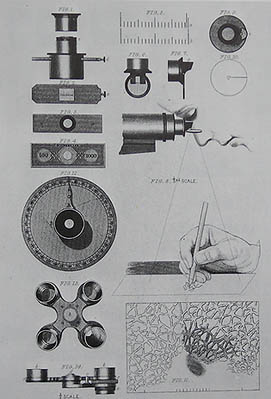
From Plate V & Plate XXII.
Smith & Beck top class objectives and eyepieces, on the right the camera Lucida attachment and micrometers.
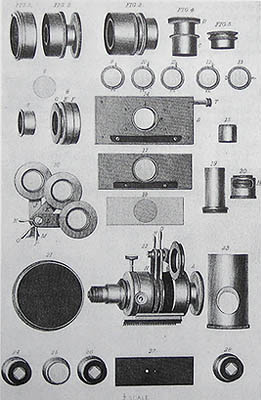
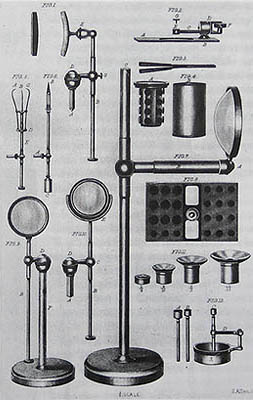
From Plate XVI & Plate X.
Polarizing apparatus, complex substage condenser, Lieberkuhns and bullseye lenses for the 1st and 2nd class stands.


'The Achromatic Microscope' 1987 facsimile of the original Richard Beck book dated 1865 and on the right, Gerard L'E Turner's 'Collecting Microscopes'.
One of the reasons I went for this stand is the excellent documentation available today including both books shown above with Turner talking about J. J. Lister, Ross and Smith & Beck's history and 'The Achromatic Microscope' going into some detail the operation of my microscope, its accessories and other microscopes in the Smith, Beck & Beck range of the period.
A Bit of History.
William B. Carpenter, The Microscope and its Revelations, 2nd Edition, 1857...
From Page 78.
...Smith & Beck's Student's Microscope.- Of the patterns yet devised for a microscope of simple construction, which shall yet be capable of answering every essential purpose whether of display or investigation, the Student's Microscope of Messrs. Smith & Beck appears to the Author to be [to say the least] among the best; and he recommends it with the more confidence, since he has for many years employed one of this kind as his own working instrument. He goes on to say that there is nothing distinctive about the stand but the construction, limb design and optics are well designed and value for money.
From Page 80.
...No working Physiologist or Naturalist can require, in the Author's opinion, a better instrument than the above; unless he be directing his attentions to some particular class of objects, which need the very highest microscopic refinements for their elucidation. The cost of the instrument fitted with two eye-pieces, condenser for opaque objects, aquatic box, and stage forceps, is [with case] about £7; he goes onto say the cost of objectives depends upon their magnifying power, 11/2" and 2/3" 3 guineas, 4/10" 5 guineas and 1/5" 6 guineas. [1 guinea = £1 1 shilling, 2 guineas = £2 2 shillings etc].
In Today's Money.
Anybody with original documents may be interested in working out what their old Victorian microscope would cost in today's money. You can get a rough idea by visiting eh.net economic history service currency calculator, you can choose from a list of requirements to suit your need, so for my microscope:
|
Item. |
Cost around 1857. |
Cost £, 2002 R.P.I. |
Cost £, 2002 Average Earnings. |
|
Basic microscope, stand & box |
£7 |
396 |
3665 |
|
1 1/2" objective |
£3 3s |
178 |
1649 |
|
2/3" objective |
£3 3s |
178 |
1649 |
|
4/10" objective |
£5 5s |
297 |
2749 |
|
1/5" objective |
£6 6s |
356 |
3299 |
R.P.I. refers to the Retail Price Index, the true cost of the microscope and objectives probably falls somewhere between the R.P.I. and Average Earnings but which ever you use it was a considerable investment at the time for those old microscopists. Note the cost of the objectives compared to the stand, the higher powers approaching the cost of the stand and box combined showing the difficulty in manufacture at the time.
Smith & Beck Best Student's Stand Serial No.1087.
Originally auctioned in February 2004 at Bonhams London Auctions I purchased it from a fairly local dealer who provided a good description, images of the microscope and accessories and I think added the bullseye lens which was missing judging from the picture shown in the auction, I had the benefit of returning the item if I was not satisfied, the microscope was in good general order, just requiring some new lubricants and careful cleaning of the lacquer and mirror with no more than damp cotton buds and a soft lint-free cloth dampened with previously boiled water. A very gentle buffing with a soft dry cloth has brought back a generally excellent lemon-gold finish with 'spotting' consummate with age.
The Stand, click on the outer two images for larger versions.
Three views of the Smith & Beck student microscope. Smith & Beck's details are engraved on the tube as can be just seen in the central image between the course focus controls.
This is based upon the claw-foot, 'Y' or English stand originally found on Ross designs in the 1840's but in reverse compared to most manufacturers of the time, the main tube assembly may be moved through 90 degrees from horizontal to vertical using a friction fit enabling good stability compared to the rather 'massive' continental designs of the same era which were mostly for viewing in a vertical position and had a tendency to fall to one side or topple over if brought near the horizontal position, however I don't like this method as much as the quick release lever found on some of the other English stands. The microscope measures 15 1/2" tall in the vertical position with the draw tube closed and has a small footprint whilst the lacquer is in generally excellent condition with occasional 'spotting' typical of the age. The plain-concave mirror is attached to a long arm giving free movement beneath the substage which in turn slides up and down on a substantial brass rod with a friction clamp allowing vertical movement to provide a reasonable focus on the subject when the concave side of the mirror is in use.
The Stage.
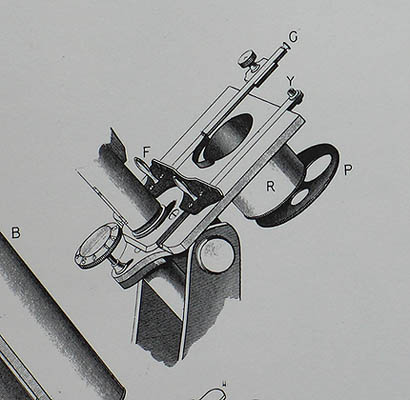
From Plate IV.
The plain compact stage [working area about 3 1/2" by 3"] fitted to my stand comprises a steel ledge running nearly the full length of the brass stage onto which two small detachable brass finger controls are screwed, [F] above, this allow the ledge to be moved smoothly in the 'Y' direction along grooves cut into the stage, the 'X' movement is simply achieved by gently pushing the slide each way. Although the scheme is simple it works quite well since the position of the finger controls and fingers resting at the edge of the slide allow fairly smooth movements after a bit of practice. A sliding piece [G] with spring attachment [missing from my microscope] was used to stop unnecessary movement of the slide whilst being positioned with the fingers and also prevented the slide toppling when the microscope was used horizontally when the camera Lucida was in use. At the other top side of the stage a small socket [Y] allowing the use of the stage forceps, cleverly designed to move with the movement of the 'Y' stage controls. Also to be discussed below you can see the 'quick-release' bayonet fit substage carrier [R] which accepts various substage assemblies by a simple push fit and in this case with the standard diaphragm plate attached [P]. Carpenter in his 1857 2nd Edition book 'The Microscope And Its Revelations' suggests that the higher priced stage with 'X' 'Y' stage controls made the available space on the stage rather cluttered and he preferred the simpler system fitted to mine [and his]. Supplied with the microscope was an original large Smith & Beck glass slide with a strip glued to the lower top edge allowing small amounts of water from say a pond sample to be studied at low powers without the water disappearing off the slide when the microscope is in the normal angled position.
The Substage.
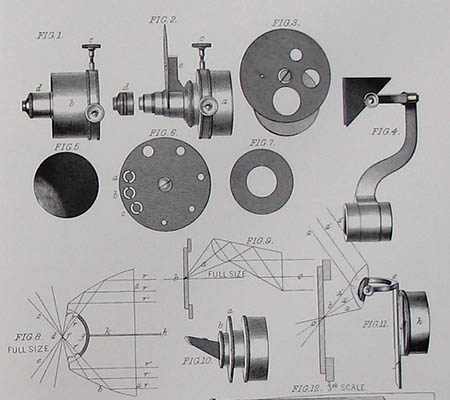
From Plate VI.
Smith & Beck provided an excellent but most likely very expensive *achromatic condenser with substage adjustment for their 1st class stands shown in Fig.2 above for use with or without top lens, the numerical aperture is 0.54 with top lens and 0.35 without, they also provided a simpler push fit centreable condenser for the student stand shown in Fig.1 [which seems to be based upon nothing more than an objective in a mount], but this was only available at extra cost. My microscope can also take the diaphragm plate shown in Fig.3 normally fitted as standard, the substage attachment comes in two parts, a brass bayonet fit tube which is easily detachable from beneath the stage if necessary and this is then used to accept the diaphragm plate, condenser, or you can use the darkwell attachment all by simple push fit. In Fig.3 you can see three apertures the central one of which I have attached a small circular polarizer by two tiny spots of rubber adhesive used because it can be removed without trace if required, the alignment was carried out accurately for the standard E-W orientation using Biotite crystals when swung into its 'click' position. The apertures were all used to limit glare when the low power objectives are used and with the central aperture in position including my polarizer it provides a good match to my 1 1/2" objective. The limit to which high power objectives can be used without a condenser but simply using the concave mirror is interesting since some tests done recently with a Baker 1/8" my brother and I were surprised that we could see fine detail on a Klaus Kemp diatom slide even though when looking down the main tube with eyepiece removed we only observed a tiny spot of light beaming at us rather than the usual 2/3 to 4/5 of full aperture you would normally be aiming for when using an Abbe condenser with a modern achromat. Artifacts from such a small aperture are very clear...most notably evidence of 'floaters' in the eyes etc but the image was remarkably good and quite satisfying, especially since my brother had just been working on it and had just completed its major restoration!
*The cheaper to manufacture Abbe condenser [also on adjustable substage] was not invented yet and would not be introduced until some years later, initially found on Continental stands. The future would see the Zeiss Jena factory and Prof. Ernst Abbe working together on new optical theory and designs.
Course Focus.
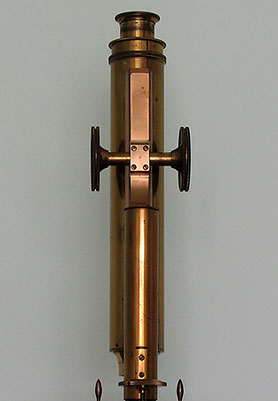
The rack and pinion is of the straight type being earlier in origin to the now familiar Swift & Son diagonal design [introduced in 1881 to provide a better feel and less wear] but except for a little 'slack' in the mechanism it provides very smooth operation from the big controls and is accurate enough for use with the objective like my 4/10" without using the fine focus. The mechanism is easily dismantled to be cleaned and re-lubricated. Also, if you look just at the bottom you can see the finger controls for moving the slide in the 'Y' direction. Unlike many of the designs at the time there is zero lateral movement when the rack and pinion focus is in use this is due to the excellent tolerances and the Jackson-type groove running the full length of the main tube assembly. A draw tube fits within the main tube calibrated in inches providing variable magnification with the erecting tube and also with just the objectives in place, however this is such a good fit it is not easy to use and I leave it fully collapsed into the main tube and in this position provides the standard English tube length of 10" [250mm].
Fine Focus.
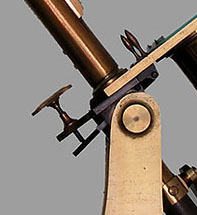
A finely milled steel screw with calibrated brass wheel 0-9 is directly connected beneath the stage this pushes against a thrust plate and by a clever arrangement moves the main tube assembly up and down being very accurately centred by a supporting rod in close proximity within. This arrangement provides good fine focus with just a modest amount of 'backlash' on my sample using the 4/10" objective and No.2 eyepiece providing over 200x magnification.
The Objectives.
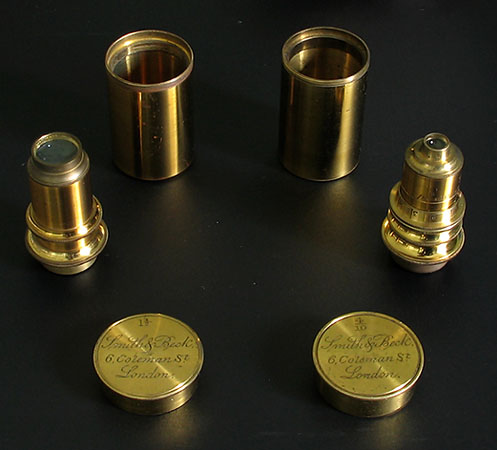
Objectives supplied with the microscope.
Signed cans, beautiful lacquer and clear optics for the 1 1/2" and 4/10" objectives supplied with the microscope, you can see the correction collar on the 4/10" which moves the front element which is not a problem due to its good working distance. If objectives like these are stored in their canisters within the box in a dry environment they should remain clear and bright with good lacquer even after 150 years, beware of microscopes in auctions shown with the objectives on the scope, say on a turret, that look dull with poor lacquer and pitted chrome [if fitted], there is a good chance the internal optics could be showing 'crystallisation' of the lenses especially if fluorite has been used or internal 'fogging' to the doublets either through atmospheric pollution or the balsam adhesive breaking down, this sometimes can be remedied depending on the design but there is a good possibility you can make it even worse than it was! Unfortunately the 2/3" objective was not included so I cannot use the erecting tube, darkwell's or the single Lieberkuhn which has the correct diameter for the 2/3", a shame. Although the Royal Microscopical Societies [R.M.S.] standard thread was shortly to be agreed upon, these objective threads already conform to that standard.
Shown below is the complete objective range shown in Richard Beck's book of 1865, of which the 1 1/2" and 4/10" were supplied with my scope, I think there was cost saving if you bought pairs together like my set.
The table is derived from the Abridged Numerical Aperture table, Hogg 15th Edition 1898, Page 58.
|
Objective. |
Approx' Magnifying Power. |
Angular Aperture. Degrees in Air. |
Equivalent Numerical Aperture. |
|
|
|
|
|
|
3" |
3x |
12 |
- |
|
2" |
5x |
18 |
- |
|
1 1/2" |
6.6x |
23 |
0.2 |
|
2/3" |
15x |
35 |
0.31 |
|
4/10" |
25x |
55 |
0.46 |
|
4/10" |
25x |
90 |
0.71 |
|
1/4" |
40x |
75 |
0.61 |
|
1/5" |
50x |
85 |
0.68 |
|
1/5" |
50x |
100 |
0.77 |
|
1/8" |
80x |
120 |
0.87 |
|
1/20" |
200x |
140 |
0.94 |
I am at a loss to why there are two angular apertures given for the 4/10" and 1/5" since these are not shown as two distinct types in any of the information I have found. It must be remembered that the magnifications listed are for the English tube length of 10" [250 mm] compared to the much shorter tube length of 160mm typical of the Continental designs. For example using the 2/3" objective, magnification = tube length [10"] / 2/3 = 15x. The 4/10" and above objectives all have cover slip correction but for modern cover slips and slide preparations I have found a setting approximating to 'uncovered' suitable.
The Eyepieces.
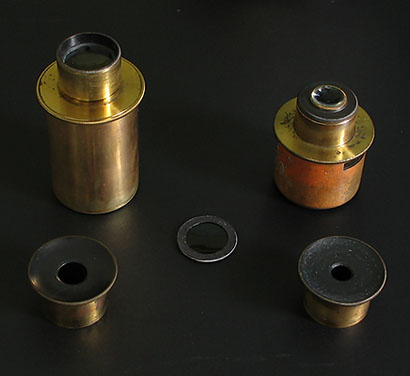
No.1 and No.2 eyepieces with detachable brass and painted tops, the small analyzer I have made, shown centre, fits under the eyepiece tops and the whole eyepiece rotated for best extinction. The eyepieces are very easy to clean due to the fact they can be totally disassembled into their component parts and provide a very bright image with excellent black background at the field edge. The eyepieces are weighty and much larger than found typically on modern stands, it was not untypical to find only 2 objectives supplied with a microscope and 3 or 4 eyepieces since it was cheaper to manufacture the eyepieces than the more complex objectives but still provided a good range of magnifications to choose from.
Typical of both English and Continental manufacturers, eyepieces were generally labeled either A, B, C or No.1, No.2 etc. Somewhat later, actual magnifications were added to the description on the eyepiece, shown below is the total magnification table for my eyepiece-objective combination showing a good range from 30x to 210x, a reasonable limit with no substage condenser, the best results are with the No.1 eyepiece.
From Richard Beck's 1865 Data.
|
Supplied Objective. |
No.1 Eyepiece [Approx' 5x]. |
No.2 Eyepiece [Approx' 8 1/2x]. |
|
|
|
|
|
1 1/2" |
30x |
56x |
|
4/10" |
120x |
210x |
|
4/10" |
146x |
255x |
The 4/10" is listed twice since I am uncertain which one I have, although from the results I would say the NA 0.46 version.
*All magnifications with the draw tube closed.
Accessories.
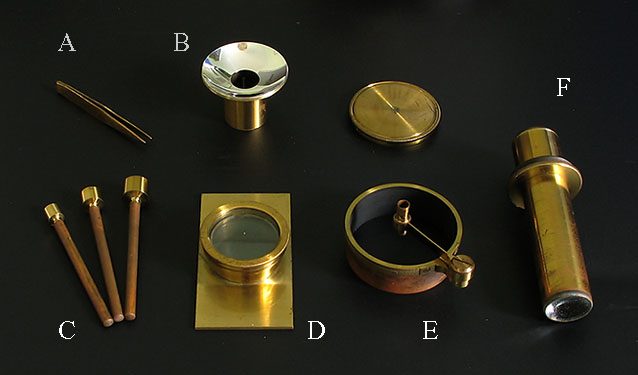
Nice collection of accessories came with microscope, unfortunately some of them cannot be used at present.
A. small tweezers, B. Polished silver Lieberkuhn with dust cover for attaching to the 2/3" objective to illuminate opaque objects from above with a light source directing at the mirror below and reflected up, C. Darkwell's to provide a black background whilst using the Lieberkuhn, D. Livebox with basic push fit, E. Substage attachment to house the darkwell's, F. Erecting tube with optics to be used with the 2/3" objective and draw tube to provide a low power, variable magnification erect image through the microscope.
The Mahogany Box.
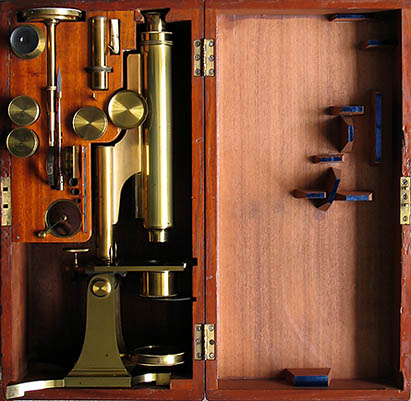
This can be used vertically, easier when removing the stand and then on its back to allow easy access to the accessories. The box is still in good condition with original blue velvet trim, although like many of these boxes the key is missing and at some time somebody has forced the lid causing moderate damage to the wood, I think I can still obtain a key for the simple 2 lever lock from a locksmith. The picture also shows the small bullseye lens used for illuminating opaque subjects from above using an artificial light source. No documentation was found within the box.
Lock.

The lock cover was missing so I have made a template from thin aluminium presently held in place by rubber adhesive ready to copy the outlines to a piece of brass when I can find some suitable.
Illumination.

From Plate XXIII.
Artificial light sources of the period.
A Typical 'Evening Scene'.
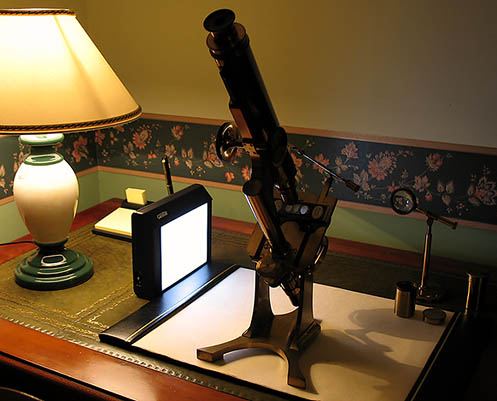
A typical setup at my writing desk with the 1 1/2" objective in place looking at a Victorian paper covered slide preparation. As suggested by Beck the illuminating source [in my case provided by my low wattage daylight corrected Jessops 'cold light' normally used for inspecting photographic 35mm slides] is used within 10" of the microscope, placed to the left, this gives a beautiful neutral background and is sufficient for low power crossed-polars. The shaded light of low wattage gives a nice 'Victorian ambience' with little glare when looking at slides whilst the stage forceps can be seen attached to the stage swung out of position.. The bullseye for opaque subjects and objective cases can be seen towards the right. For oblique illumination the mirror can be swung at various angles on its long pivoting arm, when creating very oblique effects the substage assemblies should be removed.
Some Interesting Dates Following my 1856 microscope.
1858. The Microscopical Society thread, [R.M.S. thread] for objectives becomes standard across manufacturers.
1860. Angle of aperture of an objective reaches 170 degrees, approaching the theoretical limit of 180 degrees.
1866. The Royal Microscopical Society is formed previously known as The Microscopical Society of London, J. Lister and Ross being founder members.
1870. The decade in which Professor Ernst Abbe of Jena University working in collaboration with Carl Zeiss, the Jena microscope maker studies the formation of images in the microscope following the principles of physics with regards to light as wave motion, microscope optics and design to be found to the present day.
1900. The Continental or 'horseshoe foot' becomes more widely used by English makers due to the popularity at this time of the German stands.
Best Numerical Aperture Of Objectives Using Different Mediums In The 19th Century.
|
Date. |
Air. |
Water. |
Oil. |
|
|
|
|
|
|
1820 |
0.1 |
- |
- |
|
1840 |
0.6 |
- |
- |
|
1860 |
0.9+ |
- |
- |
|
1880 |
0.9+ |
1.23 |
1.3 |
Table showing increase of NA in the 19th century, derived from a graph in Turner, 'Collecting Microscopes', page 15.
Resources.
Several books were invaluable in finding out more information on my microscope, objectives and history of microscopy in general, providing the main source material of this article, as follows:
Facsimile, 'A Treatise on the Construction, Proper Use, and Capabilities of Smith, Beck, and Beck's Achromatic Microscopes' by Richard Beck 1865, shortened to 'The Achromatic Microscope' published by Science Heritage Ltd (Illinois, USA), 1987.
'Notes on Modern Microscope Manufacturers', Brian Bracegirdle. 1996, pub. Quekett Microscopical Club, London. Still available new from Savona Books.
'Collecting Microscopes', Gerard L'E Turner, a Christie's International Collectors Series, Mayflower Books, New York, 1981.
'The Microscope and its Revelations'. William B. Carpenter, MD. 2nd Edition, 1857.
J Hogg, The Microscope, 15th Edition, 1898.
Some of these books can still be found by checking the abebooks second hand books network.
If you have enjoyed reading this and haven't seen my previous article on Victorian microscopy books you may like to see http://www.microscopy-uk.net/mag/artfeb05/iwoldbooks.html were I discuss my interest in them.
Conclusion.
A compact, elegant stand by a reputable maker of the time, it provides more versatility than many of today's microscopes due to its stage forceps, novel illumination methods and erecting tube which, as well as providing an 'upright' image allows continuous total magnifications from 5-100x using the 2/3" objective and draw tube. The objectives and eyepieces are bright and clear providing very good images considering their age, field flatness is not as good as modern plan objectives but you wouldn't expect this and indeed most English makers of the time were striving to improve numerical aperture for greater resolution whilst trying to balance this against reasonable flatness of field.
![]()
Comments to the author, Ian Walker, are welcomed.
Please report any Web problems or offer general comments to the Micscape Editor.
Micscape is the on-line
monthly magazine of the Microscopy UK web
site at
Microscopy-UK
© Onview.net Ltd, Microscopy-UK, and all contributors 1995 onwards. All rights reserved. Main site is at www.microscopy-uk.org.uk with full mirror at www.microscopy-uk.net .